Our view at Stack - Pipedrive is a robust CRM platform, offering automation, contact data collection, webhooks, AI-powered sales assistant, email communications, email marketing, and customisable sales pipeline workflows.
Timing, goals and a good understanding of your customers are important for flash sales. Even the most enticing discounts can flop if your sale doesn’t align with your customer’s habits and preferences.
A well-planned flash sale, on the other hand, can boost sales, clear excess stock and attract new customers.
In this article, you’ll learn what a flash sale is, its pros and cons and how to run a flash strategy for your business.
What is a flash sale?
A flash sale is a short-term, limited-time promotional event that offers customers deep discounts or special deals. These sales typically last anywhere from a few hours to a couple of days and create a sense of urgency to encourage quick purchasing decisions.
Flash sales are particularly popular during shopping events like Black Friday and Cyber Monday, where online stores compete to offer the best flash deals in a short period of time.
Products or services in these online sales may be available only during the sale period. For example, sleep fitness brand Eight Sleep offered a $200 discount on its Pod Pro for 48 hours.
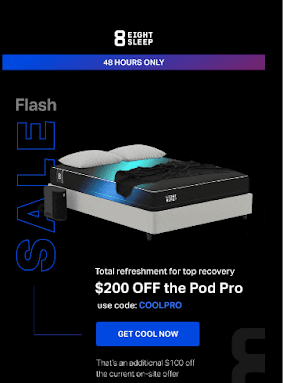
Flash sales boost sales quickly, clear inventory and attract new customers. They’re popular in e-commerce, but brick-and-mortar retailers also use them.
Is a flash sale worth it for your business?
Weigh the potential benefits against the risks for your specific business. Consider factors like your profit margins, inventory levels and long-term brand strategy. Flash sales have both pros and cons.
The pros of flash sales
| Boost sales and revenue quickly |
An influx of orders improves your bottom line, especially during slower periods. You can achieve results that typically take weeks or months in a short window. |
| Attract new customers and re-engage existing ones |
Flash sales build brand awareness, remind dormant customers of your brand and products and move leads through your marketing funnel. |
| Clear out excess inventory or seasonal products | A flash sale frees up warehouse space and reduces holding costs. You can recoup some of your investment by moving these products. |
| Create a sense of urgency and excitement. |
Urgency often translates into quick decision-making and impulse purchases. Stats show 66% of Gen Z shoppers and 67% of millennials will wait for lower prices before buying. Flash sales tap into this pent-up demand. |
| Generate buzz and social media engagement |
Customers often share great deals with their friends and family, providing organic, word-of-mouth marketing. Increased social media activity can boost your brand visibility. |
The cons of flash sales
| Can impact profit margins with poor planning | Discounts intensify industry competition when firms compete for short-term cash flows. Heightened competition often leads to a race to the bottom, potentially harming industry profitability. |
| May only attract bargain hunters vs. repeat customers |
Flash sales attract price-sensitive shoppers who might not become loyal customers. Bargain hunters only buy during discounts, undermining efforts to build a stable customer base. |
| Risk logistical challenges if demand exceeds expectations |
Unexpected surges in demand can overwhelm inventory management, shipping and customer service resources. Brands risk losing customer trust due to delayed shipments, stockouts or order processing errors. |
| Potentially create a negative customer experience with subpar execution |
Poorly managed flash sales frustrate customers with out-of-stock items, long wait times and confusing policies. These types of problems can make customers question the brand’s competence. |
How to run a flash sale
Before running a flash sale, evaluate your brand positioning and whether deep discounting aligns with your long-term strategy. Once you’re sure your business is ready for it, follow these steps.
1. Define your goals
Clear, specific goals should shape every aspect of your sale, from product selection and pricing to timing and marketing approach. Goals may include:
Plan, execute and measure your flash sale using SMART goals to ensure every aspect of the sale aligns with your business objectives. For example, “increase sales revenue by 20% compared to last month” or “reduce seasonal inventory by 50% within 48 hours”.
Your goals also influence how long your sale runs and how you market it.
For instance, revenue-focused sales might align with peak shopping seasons, while inventory clearance could target end-of-season periods. Customer acquisition might benefit from broader marketing channels, while re-engagement might benefit from email and loyalty programs.
Precise goals provide clear benchmarks to evaluate your flash sale strategy and return on investment (ROI).
Want to Learn How to Influence Your Prospect’s Buying Decisions?
Get inside the head of your customers and take advantage of consumer psychology with this Psychological Selling Guide.
2. Choose the right products
Align the products you feature in your flash sale with your business goals and target market.
Here are some ideas for striking the right balance depending on your goals:
-
Increase overall sales revenue. Include your best-selling products to attract a wider audience. Feature items with higher profit margins to maximize your earnings. Offer product bundles or discounts on frequently bought-together items to encourage larger purchases.
-
Clear out excess inventory. Prioritize overstocked, seasonal or slow-moving items. Discounting these items can encourage purchases and free up storage space. Pair excess inventory with popular or high-margin items to make it more appealing.
-
Attract new customers. Showcase products currently trending or in high demand to attract a new audience and generate interest in your brand. Offer a few select items at a low price or even a loss to attract new customers. Provide special discounts or promotions exclusively for new customers to encourage them to make their first purchase.
-
Re-engage existing customers. Include a mix of popular items and new arrivals to appeal to your existing customer base and offer them something fresh. Reward your loyal customers with exclusive discounts, early access to the flash sale or bonus points on their purchases. Use customer data to recommend products tailored to their individual interests and preferences.
Keep your brand’s perceived value and customer purchasing habits in mind when selecting products.
Recommended reading

12 sales promotion examples to close more deals and set your sales team up for success
3. Determine discount amount and duration
Find the right balance between discount and duration. The discount must be enticing enough to drive purchases, while the duration should create a sense of urgency without being too short for customers to participate.
Here’s how to determine each.
Discount amount
-
Start by analyzing your profit margins. What’s the maximum discount you can offer while still maintaining profitability?
-
Consider tiered discounts to encourage larger purchases. For example, “10% off $50, 15% off $100, 20% off $150+”.
-
Think about exclusive offers for loyal customers. Could you offer them an additional discount or early access to the sale?
-
Use psychological pricing tactics like ending prices in .99 or offering “buy one, get one” deals to make discounts seem more appealing.
The goal is to create a sense of value without devaluing your brand. A too-steep discount might boost short-term sales but harm long-term perception.
Duration
Keep it short enough to create urgency. Most flash sales last between 24 to 72 hours. However, ensure it’s long enough for customers to participate. Consider your target audience’s habits and time zones.
Also, experiment with “surprise” hour-long sales or week-long events with daily deals.
Pro tip: Test different discount amounts and durations with smaller sales before launching a major event. Find the sweet spot that maximizes both sales and profits.
4. Set up inventory and logistical processes
Ensure you have sufficient stock on hand to meet the anticipated demand. Underestimating demand can lead to disappointed customers and lost sales, while overstocking can tie up capital and increase storage costs.
Analyze past sales data and trends to forecast demand accurately, considering factors like seasonality, promotions and current market conditions. Maintain a safety stock to account for unexpected spikes in demand or delays in replenishment.
Throughout the sale, monitor inventory levels in real time to avoid stockouts and adjust your marketing efforts if needed. Clear communication with suppliers and fulfillment partners ensures a smooth flow of goods and timely delivery.
When it comes to logistical processes, prepare your warehouse or fulfillment center for increased order volume by:
-
Ensuring adequate staffing
-
Implementing efficient picking and packing processes
-
Stocking sufficient shipping supplies
Set up your order processing system to handle a surge in orders by automating tasks like order confirmation emails and tracking notifications. Partner with reliable shipping carriers to ensure timely delivery and offer expedited shipping options for customers who need their orders urgently.
Lastly, prepare your customer support team to handle increased inquiries and potential issues during the flash sale.
Give them a hand by implementing Pipedrive’s Chatbot to handle common customer queries and free up your support team to focus on more complex issues.
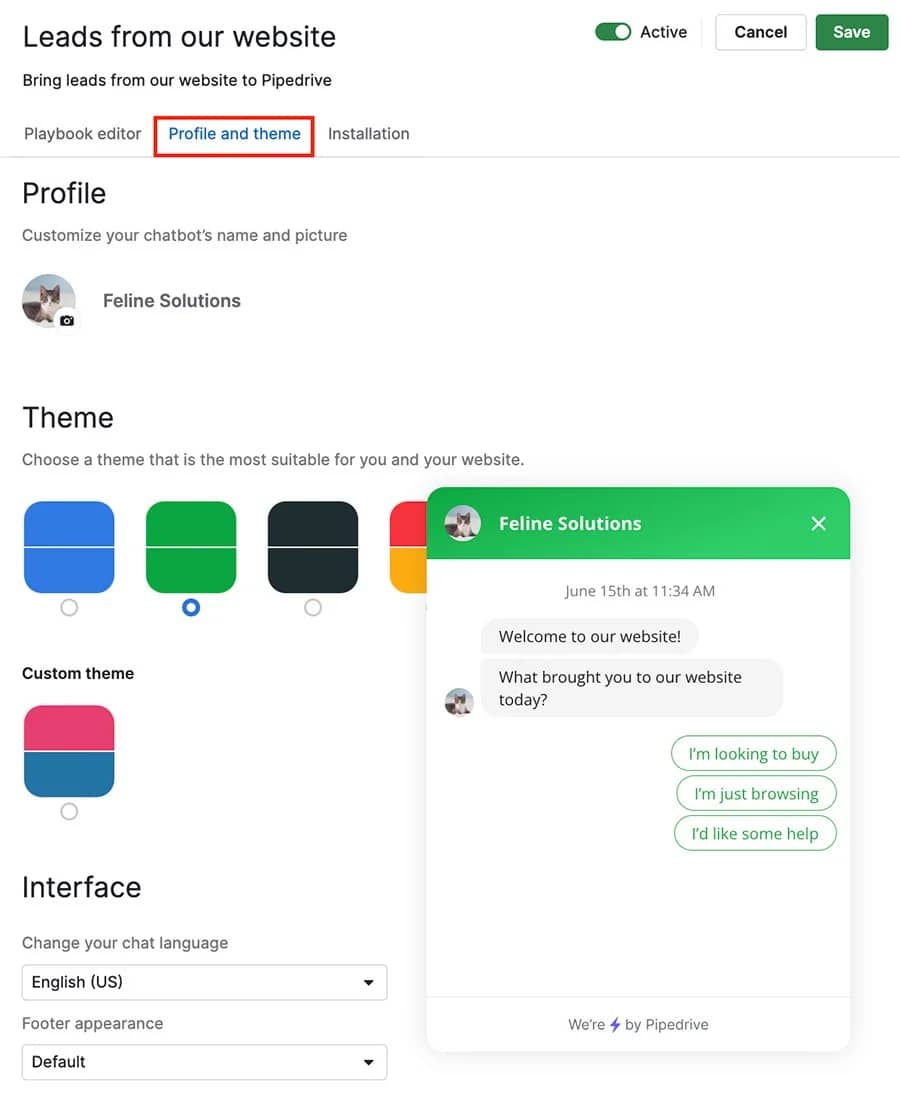
Using this tool, you can answer frequently asked questions instantly and reduce the workload on your team.
5. Market your sale
Build anticipation a week before the sale by releasing teasers and sneak peeks of the discounted products.
Create a multi-channel marketing campaign that communicates the urgency and value of your offers.
Start with displaying prominent banners on your website announcing the flash sale a week before the event. Use countdown timers and create a dedicated landing page with clear details about the offers and duration.
Complement this with posts for your social media channels. For example, Collin Street Bakery announced a sale on its strawberry products and used relevant hashtags to amplify the post’s reach.
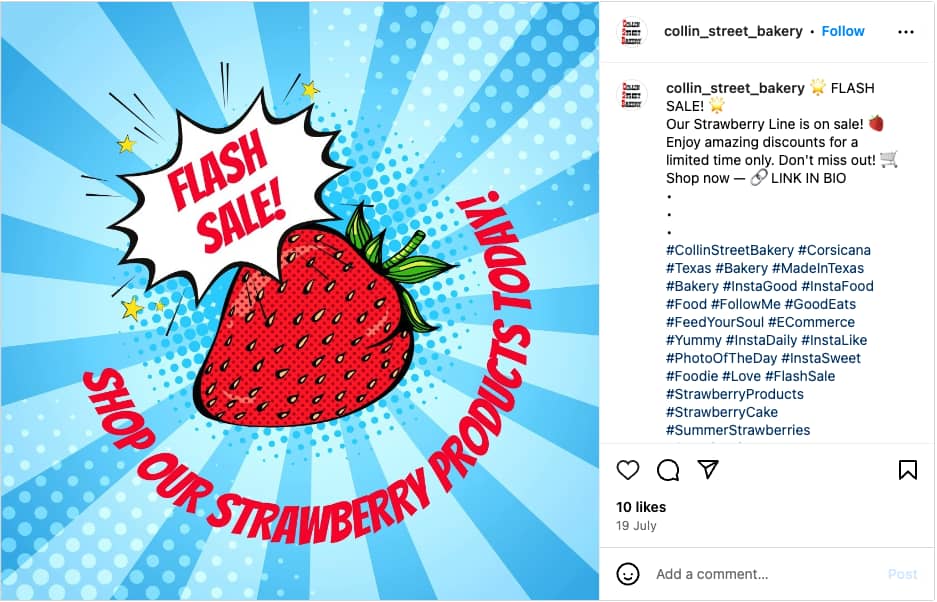
Also, use email marketing to send targeted emails to your subscribers, highlighting the limited-time nature of the sale.
To encourage your subscribers to visit your online store, create subject lines that evoke fear of missing out (FOMO).
Pay attention to your email cadence during the flash sale and balance frequency to maintain urgency without overwhelming your subscribers.
Collin Street Bakery’s “Last Chance” emails remind customers of the exclusive discounts that are about to expire in the final hours of the sale. Its email strategy typically includes a countdown timer and highlights best-selling items still available to encourage immediate action before the flash sale ends.
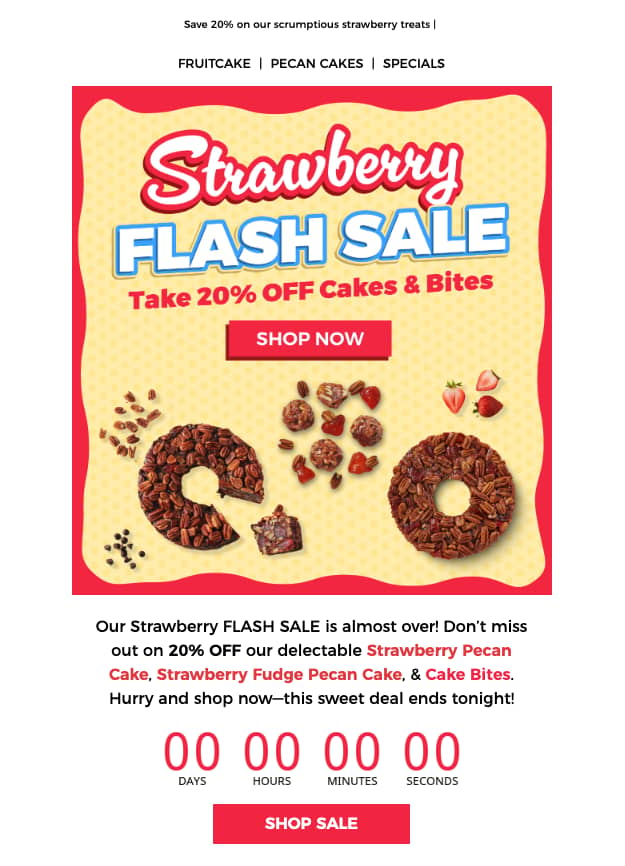
Use popups on your product pages to highlight specific products included in the sale. Automation can help manage these pop-ups and other aspects of your flash sale to ensure a smooth experience for potential customers.
After the sale, send thank-you emails to customers and offer them exclusive discounts on their next purchase to keep them coming back and reduce customer churn.
Pipedrive’s email marketing software helps you manage your campaigns from start to finish.
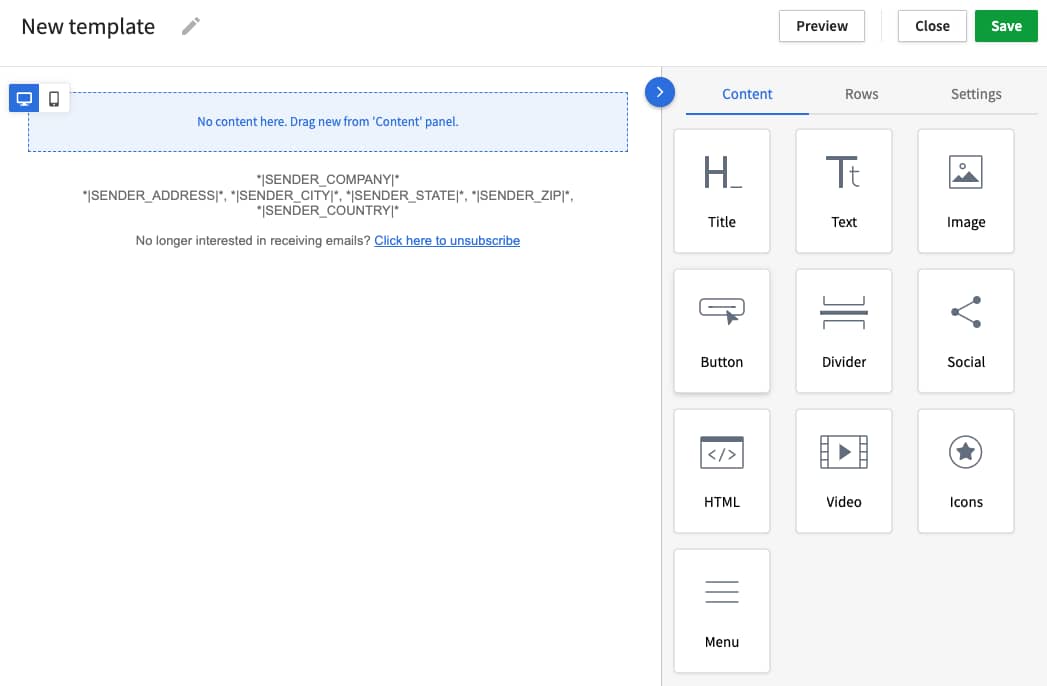
Start planning your email marketing campaign now
Click the button to receive a free email marketing campaign planner ebook
6. Analyze your sale’s success
After your flash sale ends, measure its performance against your predetermined goals. Use the analysis to understand what worked, what didn’t and how to improve future sales.
First, ask customers about their experience during the flash sale.
Were they satisfied with the products, discounts and overall process? Use surveys, social media polls or follow-up emails to collect this feedback. Monitor social media mentions and conversations about your flash sale to gauge customer sentiment and identify potential issues.
Their insights can help you identify areas for improvement and show if you ran a successful flash sale.
Next, check your sales data. Compare the flash sale performance to your regular sales periods. Look at metrics such as:
-
Total revenue generated
-
Number of orders placed
-
Average order value
-
Conversion rates
-
Website traffic
-
Most popular products
-
New customer acquisition
-
Customer retention rate
Identify any trends or patterns in the data, like:
-
Did certain products outperform others?
-
Were there specific times during the sale when orders peaked?
-
Are there any customer demographics that participated more in the sale?
Future flash sales can benefit from this information.
Consider the long-term impact of your flash sale on customer behavior and brand perception. Evaluate if the sale attracted one-time bargain hunters or led to repeat purchases and increased customer loyalty.
Then, develop an action plan for your next flash sale, replicating successful elements and addressing any weaknesses.
Recommended reading

Customer behavior: the ultimate expert-backed guide
Flash sale best practices
While knowing the basics of running a flash sale is important, paying attention to the little things can make a big difference. That means making your customers happy, building trust and getting the most out of your sale in the long run.
Focus on these best practices.
Be transparent about the terms and conditions
Transparency builds customer trust and prevents misunderstandings or disappointment during and after the flash sale.
Your terms and conditions should answer the following:
-
Who can participate in the sale (e.g., new customers, existing customers, specific regions)?
-
When does the sale start and end (including time zone)?
-
What discounts are you offering and on which products?
-
Are there any restrictions on the number of items that can be purchased per customer or any exclusions?
-
What are your shipping policies, costs and estimated delivery times? What is your return policy for flash sale items?
-
What payment options do you accept?
-
How can customers contact you if they have questions or issues?
Here’s an example of terms and conditions from a flash sale at Janie and Jack.
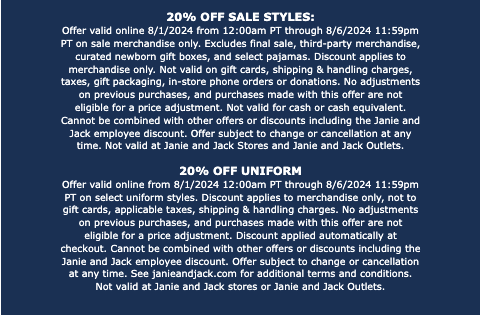
It spells out all the key details to eliminate any customer confusion.
Provide easy access to these terms on your website and in your marketing materials. Create an FAQ section specifically for the flash sale to address common queries and reduce the strain on your customer service team during the high-traffic event.
Offer a wide variety of products at different price points
Include a diverse selection of products at various prices in your flash sale to maximize its appeal.
Offering low and high price points means you can appeal to budget-conscious shoppers and those willing to splurge.
Consider including:
-
Entry-level products. Make shoppers feel like they’re getting a great deal by offering a few low-priced items like impulse-buy items or smaller versions of your regular products.
-
Mid-range products. Include a selection of mid-priced items that offer good value for money, like your best-selling products or popular items with a slight discount.
-
Premium products. Offer a few high-priced items to cater to customers looking for luxury or exclusivity like new products, limited-edition items, bundles or products with additional features.
For example, Evry Jewels offers a buy two get one free deal to purchase multiple items across different price points, potentially combining entry-level pieces with more premium selections for a personalized set.

The sales strategy caters to a wider range of customers and encourages upselling and cross-selling.
Ensure your website can handle increased traffic
A website crash during a flash sale can lead to lost sales, frustrated customers and a damaged brand reputation.
Here are some key steps to take:
-
Conduct thorough load testing before the sale to identify potential bottlenecks and assess your server capacity. Simulate high-traffic scenarios to see how your website performs under stress.
-
Optimize your website for speed and efficiency. Compress images, minify code, leverage browser caching and consider using a content delivery network (CDN) to distribute the load.
-
Choose a hosting plan that can scale up or down based on traffic demands. Cloud hosting is a good option as it offers flexible scalability and can handle sudden traffic spikes.
-
Monitor your website’s performance closely during the flash sale. Use monitoring tools to track page load times, server response times and error rates.
-
Have a backup plan in place in case your website crashes or experiences other technical issues. Have a secondary server ready to take over or a static version of your website you can quickly deploy.
Take proactive steps to minimize the risk of website downtime during your flash sale and ensure a smooth shopping experience for your customers.
Provide clear and concise product descriptions and images
Customers must quickly understand what they’re buying and visualize how the product will benefit them.
Clear and concise product descriptions and images also reduce the likelihood of returns and negative reviews.
For example, Kay Jewelers uses clear, high-resolution images that showcase the product from multiple angles and include close-ups of details and textures.

The company has also written concise, informative descriptions highlighting the ring’s specifications.
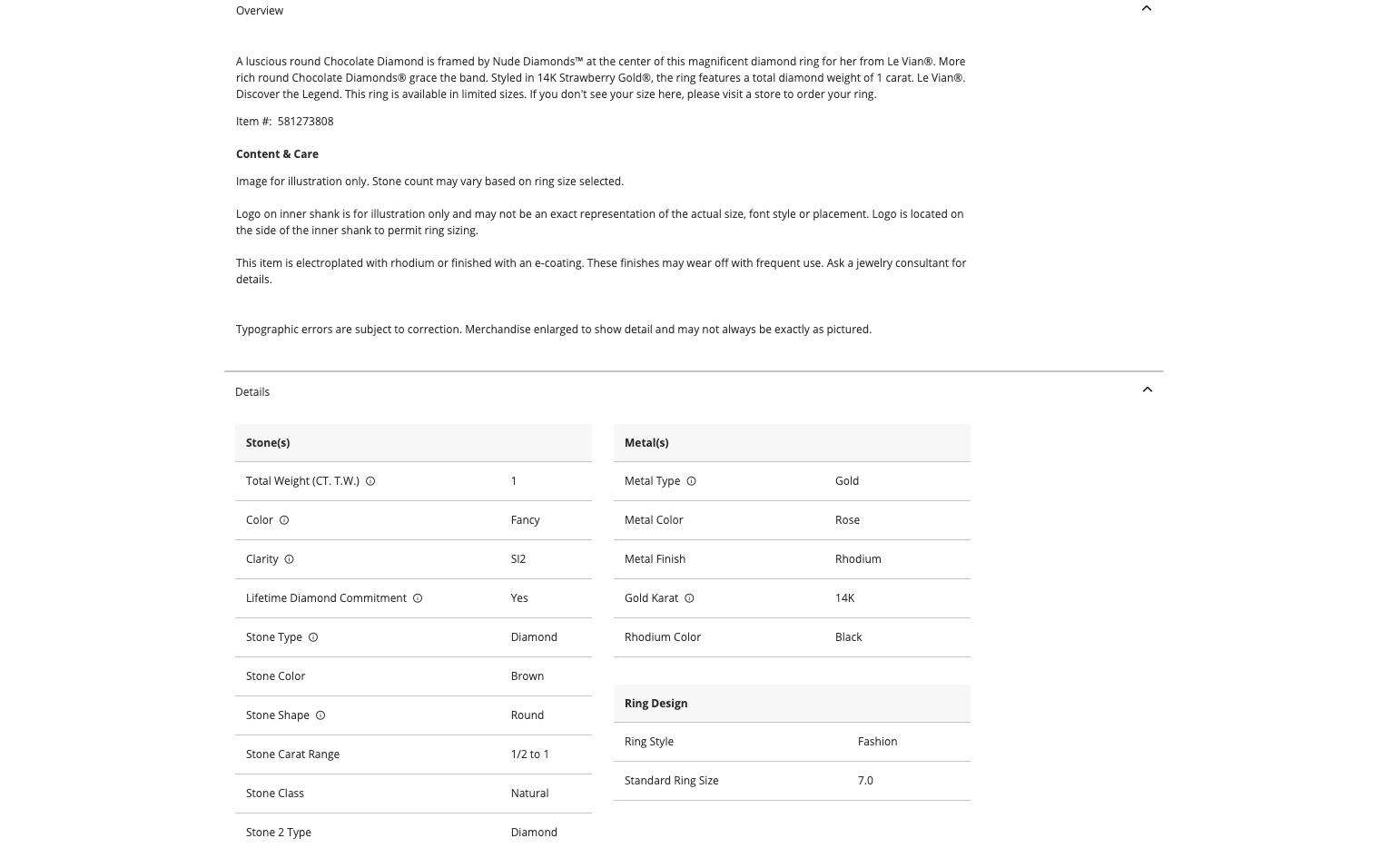
Since rings have specific dimensions, Kay Jewelers has also provided easy access to a clear size chart and detailed specifications to avoid confusion and returns.
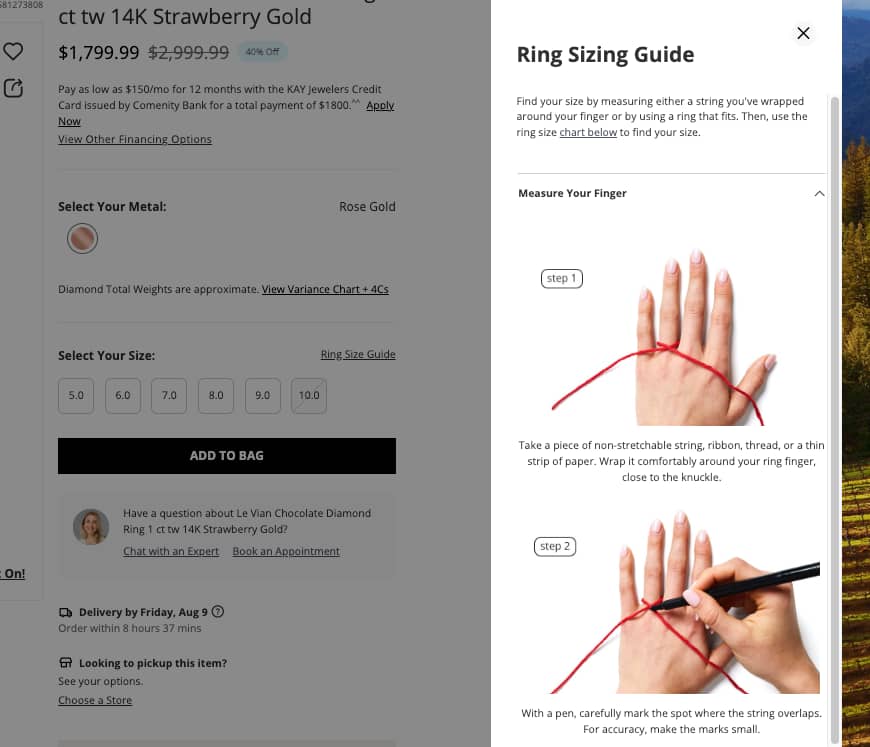
Pro tip: incorporate user-generated content like customer photos or reviews to provide additional context and build trust.
Make the checkout process as smooth as possible
A cumbersome checkout process is a major cause of cart abandonment, especially during a time-sensitive flash sale. To maximize conversions and reduce friction:
-
Allow customers to checkout without creating an account
-
Only ask for essential information like name, email, shipping address and payment details
-
Show a clear progress bar or steps to guide customers through the checkout process
-
Offer a variety of payment methods, including credit/debit cards, digital wallets (like Apple Pay and Google Pay) and buy-now-pay-later options
-
Enable autofill for addresses and payment information
-
Display security badges and trust seals to assure customers that their payment information is safe
-
Provide clear and helpful error messages if customers make mistakes during checkout
-
Display a clear order summary before the final payment step, including the items purchased, prices, discounts, taxes and shipping costs
Streamlining your checkout process and removing any unnecessary friction creates a positive customer experience that encourages customers to complete their purchases.
Final thoughts
When done right, flash sales can be a powerful marketing tool. Their success depends on timing, preparation and customer-focused strategies.
There’s no universal formula for the perfect flash sale, but analyzing metrics like conversion rates, average order value and customer feedback gives you information that can help you refine your strategy. Iterate on your flash sale approach to identify what your audience responds to.
Start your free trial of Pipedrive today and streamline your flash sale planning and execution.
If Pipedrive is of interest and you'd like more information, please do make contact or take a look in more detail here.
Credit: Original article published here.
